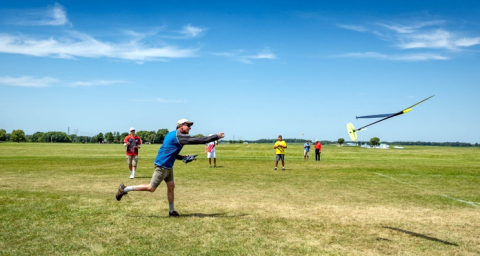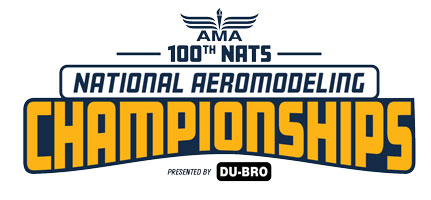
The 2020 Indoor Free Flight Nats has been canceled. The Outdoor Nats will be held July 12-August 5 at the International Aeromodeling Center, in Muncie, Indiana. You can learn more about the 2020 Nats at modelaircraft.org/nats.
Don’t forget that if you’ve never attended the Nats, the $50 registration fee is waived for you this year. Online Nats registration opens March 1!
In this second blog of the series, written by Wally Adasczik, learn what makes the RC Soaring Nats fun and exciting.
Right off the bat you have to ask what is the fastest flying model aircraft in existence? Is it a powered airplane with a propeller in the front? Nope. Maybe it’s a model jet. That would be the big nope there also. To satisfy your curiosity, it is a model sailplane! Yeah man! At speeds exceeding 500 mph! This aspect of Soaring is called Dynamic Soaring. A pilot uses mountain wind to help achieve those speeds in a closed-loop flying fashion.
Have you ever seen a glider fly cross-country? The task at hand is to get your sailplane as high as you can and then jump in the back of a country Cadillac and drive down a road to a point some 6.2 miles (or 10 kilometers) away and then fly back. Many have tried and many have not made it.
This aspect of Soaring is challenging. Trying to find thermals to keep your aircraft aloft while driving down the road is maddening. This is a team-oriented event. You need a driver, a “country Cadillac” or convertible, a spotter who hangs with you in the back and provides uplifting information—some good some bad—and you, as the pilot ,can either listen or not, all the while sitting in your beanbag or leaning on something as you tool down the road lubed up with sunscreen so you don’t burn your face.
Anybody can stand in one spot and fly for 10 minutes, especially on a good day when the sky is active. It is much harder chasing the sailplane around. A team in Nevada just eclipsed the 200-mile mark!
You are always thinking about how to get down the course without losing sight of the sailplane, landing out and trying to find the aircraft in a bean or cornfield, or worse yet, crashing because your battery ran out of juice.
If you like flying low, learning how thermals react closer to the earth, and really like exercise, then F3K is for you. These little beauties are roughly 2 meters in wingspan and weigh approximately 8 ounces. You have to throw them in the air. As many as 10 tasks play into the competition. Some are short, some are ladder type where you have to finish one task before you can start the next level, and there is even a game of poker!
If you like sailplanes that you have to build that are from circa 1980 or earlier, then the Nostalgia game is for you. These sailplanes are from the Golden Age of Soaring when life was all about design. Back then, most sailplanes only had a rudder and elevator. Some had spoilers to help you get down, but all were built using balsa wood and some type of covering. (See picture below.)
A play on that old-time flying brings us into the 21st century when carbon fiber and Kevlar are used with a modicum of balsa wood to create the RES category of flying. This is like the old school of just Rudder, Elevator, and Spoiler. The big difference is that these sailplanes have two to three times the performance of the old balsa airplanes. Here is a picture of the RES flightline.
Other facets of sailplane contesting are 2-Meter sailplanes where the wingspan can’t be any larger than 2 meters. These sailplanes are mini-Indy race cars. They fly that fast and maneuver accordingly.
Just when you think you have a handle on that, there is Unlimited. As the name states, you can fly anything. Anything old, anything new, anything small, and anything huge … up to a point. This is a picture of Unlimited and a pilot making a spot landing.
As with all of the contests (except cross-country), the basis of the game is to stay up for 10 minutes after launch and land within a predetermined circle or spot. Most of the contests have a 100-inch circle. The closer the airplane lands to the center, the more points you get. Time is kept via stopwatch and a penalty is incurred for every second over or under 10 minutes. It is a mind game! If you have a good person running your stopwatch, he or she will tell you about what other people are doing. Maybe you are not in a thermal but other people are. There is no pride in poaching that thermal!
The F3B class is the Formula 1 of the Sailplane model classes. It’s the high-tech class without technological limits. We have not flown F3B at the Nats in many years. This class is very small here in the US and is hugely popular overseas.
The F3B contests are a tremendous challenge, thrilling, and ask for power of endurance and team spirit. This is a task-oriented contest within a contest. You have three tasks to perform:
- Ten-minute duration
- Four-minute distance flight over a 150-meter closed circuit
- Speed flight over four laps on a 150-meter closed circuit
The League of Silent Flight (LSF; www.silentflight.org ) used to host banquets and that tradition petered out. A few years ago, a new management team took over and an opening night dinner was proffered. Then a midweek barbecue was also provided.
For many of the Nats folks, it’s not about the contest, it’s about seeing old friends and getting hugs and finding out who made the trip around the sun again or who took their final nap and became a silent wing.




















